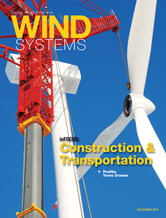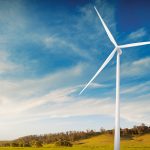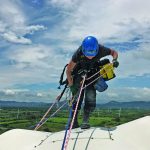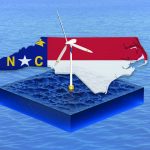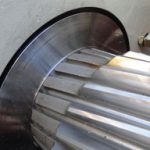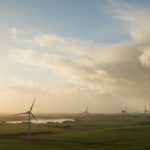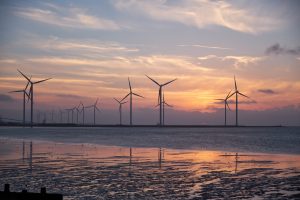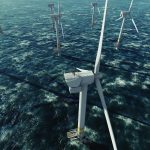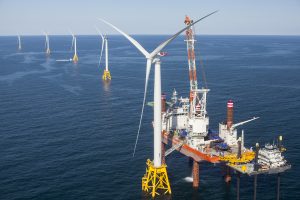The growth of the wind industry in the last decade has brought with it a push for higher efficiency wind turbines and the ability to bring wind power to geographical areas once thought unsuitable for wind-farm installations.
With the challenges and costs associated with transmission of wind power over long distances, the industry has shifted toward the use of larger, more efficient wind turbines with longer blades. The average rotor diameter has increased from 75 meters in 2005 to 102 meters in 2015, according to the American Wind Energy Association. The taller the hub height and the larger the rotor diameter, the larger the sweep area, which makes these “supersized” turbines more efficient and also suitable for installation in lower-speed wind markets.
Many manufacturers are now producing blades up to 57 to 62 meters long, but this increase in blade length has created some unique challenges for manufacturers and developers when it comes to transporting them from their point of origin to the final project site. The options for transporting these larger blades are often limited and come with more risk, time, and cost.
A full route survey and analysis should be performed to identify transport and route options, permit requirements, and the risks associated with each mode.

Over-the-Road Transport
Specialized stretch blade trailers are required to haul any wind-turbine blade, but there is a limited number of trailers available long enough to transport 57-plus-meter blades. Most blade trailers were originally purchased and designed for double transport of 40-meter blades, which was the industry standard until 2011.
Manufacturers are actively creating new trailer designs, but most have not seen a great deal of blade trailer orders in the past few years. Some trailer companies have performed custom modifications to their fleet to meet wind manufacturer demands, which includes relocation of the tip fixture to the rear pullout with reinforced beams.
Beam inserts can also be added to existing trailers to extend the overall trailer length in 15-, 20-, and 25-foot increments. However, once the beam inserts are in place, they cannot be collapsed into a “legal load” and must be permitted even when moving empty. Not all specialized blade trailers have beam-insert capability, which further reduces the number of available trailers. This option is good; however, the increased permit requirement plays a large role in asset management and rotation time of this specialized equipment.
The largest available trailers can stretch to about 180-plus feet without modifications and are capable of transporting blades up to roughly 62 meters in length. However, this size trailer is used less often because of the transport and permitting challenges associated with their length. The more commonly used non-modified trailers, in the 155-foot range, can move wind blades up to 56 meters due to the federal law allowing for up to 30 feet of rear overhang. There is limited enforcement of this regulation in many states, but issues may arise as the volume increases. Some states will increase the maximum rear overhang on limited routes, but many will flag the loads and request additional verification.

And the rear overhang regulations are only the first hurdle. Permits will take longer and be more difficult to obtain, and loads will require additional police escorts, adding to the transit time and cost. Increased rear overhang also means a higher risk due to the larger turning radius and tip swing. Along the route, signs and utility poles may need to be removed temporarily to prevent damage, which increases the lead-time on permit approvals and transport. With proper pre-planning and relationship development with state entities, special allowances can be created on a project-by-project basis.
The “last mile” to the project site is often high risk due to narrow roadways and shoulders that require modifications and improvements prior to transport, which again add to the time and cost associated with the move.
The U.S. road network also presents challenges for moving larger wind blades by trailer, since most source locations require routing through or around major city centers. Many of these blades are imported into Gulf and West Coast ports, which requires moving them out of heavily populated areas onto the U.S. network of super-load corridors. A rough average of 700 miles from origin (port or U.S. manufacturer) to project site means more potential issues with permitting, road improvements, sign removal, and clearances.
Additional Transport Options
Depending on the point of origin — whether a port or U.S. manufacturing plant — some developers or manufacturers may be able to consider other transport mode options besides over-the-road transport, including the use of a barge.

The Mississippi River can be used to move wind blades via barge from New Orleans, extending the source location northward. The issues associated with this mode of transport include the increased time (average of three to four weeks to transport blades from New Orleans upriver to Iowa) and the elevated risk due to more touch points in the supply chain with onloading and offloading.
Transporting larger blades via rail is another option that can extend the source location farther inland. The use of rail has become much more common in the last year due to the challenges and costs associated with moving 57-plus-meter blades over the road.
Rail is a more cost-effective mode, especially for long distances, but it has come with its own set of challenges as the size of wind blades has increased. To minimize tip swing and potential damage to the blades, changes to the way they are loaded and attached to the rail car have been necessary. These modifications require time for design and testing, as well as the associated cost.
Future Outlook
The trend towards larger and more efficient wind-turbine blades will continue, requiring more creativity in both their design and transport options. Modular and jointed blades, some of which can be assembled on site, are being developed and tested by manufacturers. However, it may take years for this technology to become competitive with the conventional designs due to the issues with joint strength and stability. Until that happens, the transportation options for wind-turbine blades will have to continue to evolve to address the demands of the market.
















